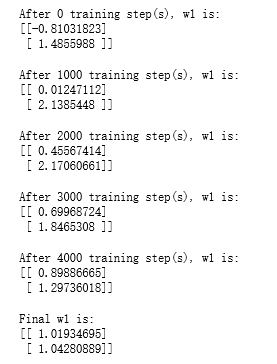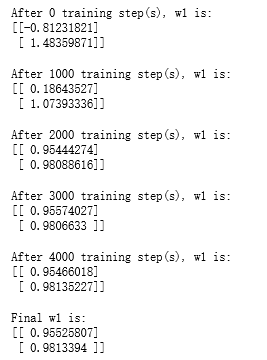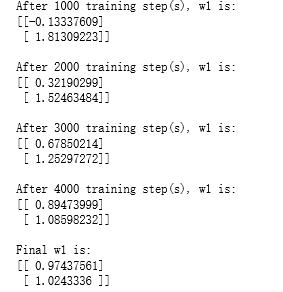吴裕雄 python 神经网络——TensorFlow 自定义损失函数
import tensorflow as tf
from numpy.random import RandomState batch_size = 8
x = tf.placeholder(tf.float32, shape=(None, 2), name="x-input")
y_ = tf.placeholder(tf.float32, shape=(None, 1), name='y-input')
w1= tf.Variable(tf.random_normal([2, 1], stddev=1, seed=1))
y = tf.matmul(x, w1) # 定义损失函数使得预测少了的损失大,于是模型应该偏向多的方向预测。
loss_less = 10
loss_more = 1
loss = tf.reduce_sum(tf.where(tf.greater(y, y_), (y - y_) * loss_more, (y_ - y) * loss_less))
train_step = tf.train.AdamOptimizer(0.001).minimize(loss) rdm = RandomState(1)
X = rdm.rand(128,2)
Y = [[x1+x2+(rdm.rand()/10.0-0.05)] for (x1, x2) in X] with tf.Session() as sess:
init_op = tf.global_variables_initializer()
sess.run(init_op)
STEPS = 5000
for i in range(STEPS):
start = (i*batch_size) % 128
end = (i*batch_size) % 128 + batch_size
sess.run(train_step, feed_dict={x: X[start:end], y_: Y[start:end]})
if i % 1000 == 0:
print("After %d training step(s), w1 is: " % (i))
print sess.run(w1), "\n"
print "Final w1 is: \n", sess.run(w1)

loss_less = 1
loss_more = 10
loss = tf.reduce_sum(tf.where(tf.greater(y, y_), (y - y_) * loss_more, (y_ - y) * loss_less))
train_step = tf.train.AdamOptimizer(0.001).minimize(loss) with tf.Session() as sess:
init_op = tf.global_variables_initializer()
sess.run(init_op)
STEPS = 5000
for i in range(STEPS):
start = (i*batch_size) % 128
end = (i*batch_size) % 128 + batch_size
sess.run(train_step, feed_dict={x: X[start:end], y_: Y[start:end]})
if i % 1000 == 0:
print("After %d training step(s), w1 is: " % (i))
print sess.run(w1), "\n"
print "Final w1 is: \n", sess.run(w1)

loss = tf.losses.mean_squared_error(y, y_)
train_step = tf.train.AdamOptimizer(0.001).minimize(loss) with tf.Session() as sess:
init_op = tf.global_variables_initializer()
sess.run(init_op)
STEPS = 5000
for i in range(STEPS):
start = (i*batch_size) % 128
end = (i*batch_size) % 128 + batch_size
sess.run(train_step, feed_dict={x: X[start:end], y_: Y[start:end]})
if i % 1000 == 0:
print("After %d training step(s), w1 is: " % (i))
print sess.run(w1), "\n"
print "Final w1 is: \n", sess.run(w1)

吴裕雄 python 神经网络——TensorFlow 自定义损失函数的更多相关文章
- 吴裕雄 python 神经网络——TensorFlow 循环神经网络处理MNIST手写数字数据集
#加载TF并导入数据集 import tensorflow as tf from tensorflow.contrib import rnn from tensorflow.examples.tuto ...
- 吴裕雄 python 神经网络——TensorFlow 使用卷积神经网络训练和预测MNIST手写数据集
import tensorflow as tf import numpy as np from tensorflow.examples.tutorials.mnist import input_dat ...
- 吴裕雄 python 神经网络——TensorFlow 训练过程的可视化 TensorBoard的应用
#训练过程的可视化 ,TensorBoard的应用 #导入模块并下载数据集 import tensorflow as tf from tensorflow.examples.tutorials.mni ...
- 吴裕雄 python 神经网络TensorFlow实现LeNet模型处理手写数字识别MNIST数据集
import tensorflow as tf tf.reset_default_graph() # 配置神经网络的参数 INPUT_NODE = 784 OUTPUT_NODE = 10 IMAGE ...
- 吴裕雄 python 神经网络——TensorFlow 数据集高层操作
import tempfile import tensorflow as tf train_files = tf.train.match_filenames_once("E:\\output ...
- 吴裕雄 python 神经网络——TensorFlow 输入数据处理框架
import tensorflow as tf files = tf.train.match_filenames_once("E:\\MNIST_data\\output.tfrecords ...
- 吴裕雄 python 神经网络——TensorFlow 花瓣分类与迁移学习(2)
import glob import os.path import numpy as np import tensorflow as tf from tensorflow.python.platfor ...
- 吴裕雄 python 神经网络——TensorFlow 花瓣识别2
import glob import os.path import numpy as np import tensorflow as tf from tensorflow.python.platfor ...
- 吴裕雄 python 神经网络——TensorFlow训练神经网络:不使用滑动平均
import tensorflow as tf from tensorflow.examples.tutorials.mnist import input_data INPUT_NODE = 784 ...
随机推荐
- wamp修改MySQL密码
wamp默认密码为空 用户名为root: 左击wamp绿色小图标,打开phpMyAdmin ->执行 ->账号 ->找到用户名为root的修改权限&&点击修改权限 - ...
- linux php 扩展安装
phpize./configure --with-php-config=/usr/bin/php-config make && make install
- 一些常用的css
不换行 white-space:nowrap table纵向合并的单元格垂直居中 display:table-cell; vertical-align:middle; table合并横向单元格 c ...
- PostGreSql - 提取jsonb数据
本文主要介绍如何在PostGreSql中提取出jsonb类型字段中的某个key的值 参考:https://www.cnblogs.com/mywebnumber/p/5551092.html 一.简单 ...
- 概率dp 期望 逆推
题目大意: 从起点0点开始到达点n,通过每次掷色子前进,可扔出1,2,3,4,5,6这6种情况,扔到几前进几,当然对应飞行通道可以通过x直达一点y,x<y,计算到达n点或超过n 点要扔色子的次数 ...
- 504,什么是FOUC?怎么避免
Flash of Unstyled Content :用户定义样式表加载之前浏览器使用默认样式显示文档,用户样式加载渲染之后再重新显示文档,造成页面闪烁 解决办法:把样式表放到文档的<head& ...
- Go时间
package main import ( "time" "fmt" "math/rand" ) func main() { /* time ...
- Go_栈
1. 栈的介绍 2. 栈的应用 3. 栈入门 package main import ( "fmt" "errors" ) //使用数组来模拟一个栈的使用 ty ...
- C++子类虚函数表指针
最近看剑指offer,记录一下 #include <iostream> #include <string> #include <cctype> #include&l ...
- AI人工智能之基于OpenCV+face_recognition实现人脸识别
因近期公司项目需求,需要从监控视频里识别出人脸信息.OpenCV非常庞大,其中官方提供的人脸模型分类器也可以满足基本的人脸识别,当然我们也可以训练自己的人脸模型数据,但是从精确度和专业程度上讲Open ...
